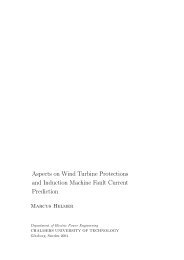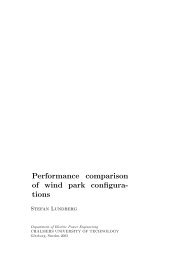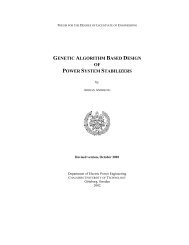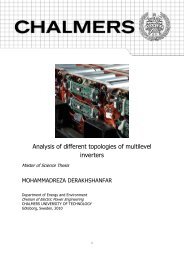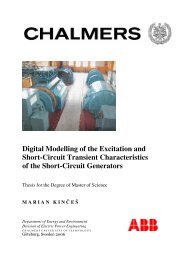LAPLACE OPERATOR.ppt [Lecture seule]
LAPLACE OPERATOR.ppt [Lecture seule]
LAPLACE OPERATOR.ppt [Lecture seule]
Create successful ePaper yourself
Turn your PDF publications into a flip-book with our unique Google optimized e-Paper software.
<strong>LAPLACE</strong> <strong>OPERATOR</strong>
Laplace operator (spatial domain)The Laplace operator is defined by:In the discrete case:wherexy2 2 2xy∂ff2 22∇ f ≡ +2 2∂x∇ f(i,j) ≡∆ f(i,j) +∆ f(i,j)∆ f(i,j) ≡ f(i,j) −f(i−1,j)∆ f(i,j) ≡ f(i,j) −f(i,j−1)∆ f(i,j) ≡ ∆ f(i+ 1,j) −∆ f(i,j)2x x x2y∂∂y[ f(i 1,j) f(i,j) ] [ f(i,j) f(i 1,j) ]≡ + − − − −≡ f(i+ 1,j) + f(i−1,j) −2f(i,j)∆ f(i,j) ≡ f(i,j+ 1) + f(i,j−1) −2f(i,j)
It follows that:Laplace operator[ ]∇ 2 f ≡ f(i+ 1,j) + f(i− 1,j) + f(i,j+ 1) + f(i,j−1) −4f(i,j)Notice that this result is proportional to:f(i,j) − 1 f(i+ 1,j) + f(i− 1,j) + f(i,j) + f(i,j+ 1) + f(i,j−1)5[ ]Hence, the discrete Laplace operator can be replaced by theoriginal function subtracted by an average of this function in asmall neighborhood:∇ 2 f = f(i,j) −f(i,j)
Laplace operator (freq. domain)∞∞∑∑f(X,X) = a U(X −m ∆)U (X −n ∆)1 2 m,n 0 1 0 2m=−∞n=−∞whereU0⎧0,n ≠ 0= ⎨⎩1,n = 0(Kronecker delta)∞∞− j(UX 1 1+U2X 2)F(jU ,jU ) = a U(X −m ∆)U (X −n ∆)e dX dX1 2 m,n 0 1 0 2 1 2−∞ −∞m =−∞ n =−∞m=−∞n=−∞−jU1X1 −jU2X2a U(X m )e dX U(X n )e dXm,n 0 1 1 0 2 2−∞−∞−j(U1m∆+ U2n ∆)∑∑ am,ne∞( ∫ f(X)U 0 (X− X')dX = f(X')−∞)m=−∞n=−∞∞∞∞ ∞ ∞ ∞= − ∆ − ∆=∫ ∫∞∞∑∑∑∑ ∫ ∫
Laplace operatorThe Laplace operator is defined by:a = 0 a =− 1 a = 0−1,1 0,1 1,1a =− 1 a = 4 a =−1−1,0 0,0 1,0a = 0 a =− 1 a = 0−1, −1 0, −1 1, −1F(jU ,jU ) = −e − e + 4−e −e1 2j∆U j∆U −∆ j U −∆ j U2 1 2 1= 4−2cos∆U −2cos∆U1 2= 2(2−cos∆U −cos∆U)1 2
Laplace operator⎡0 −1 0 ⎤⎢−1 4 −1⎥⎢ ⎥⎢⎣0 −1 0 ⎥⎦⎡−1 −1 −1⎤⎢1 8 1⎥⎢− −⎥⎢⎣−1 −1 −1⎥⎦
Laplace operator• Sensitive to high-frequency noise.• Notice the Fourier transform pairs:⎧ ∂ ⎫I ⎨ f(x,y) ⎬ = j 2 π u F(u,v)⎩∂x⎭{ }2 2 2 2I∇ f(x,y) = − 4 π (u + v) F(u,v)
Laplace operatorIt can be seen that the effect of the first and second orderderivatives on the original spectrum is that this will beweighted linearly and quadratic, respectively:WeightWeightuu
LOG filter (Laplacian of Gaussian)• It has been known since Kuffler (1953) thatthe spatial organization of the receptivefields of the retina is circulary symmetricwith a central excitatory region and aninhibitory surround.
LOG filter (Laplacian of Gaussian)
LOG filter (Laplacian of Gaussian)G(x,y)212e2 2x + y−22σ= πσ[ ] [ ]Compute:∂∂G(x,y) G(x,y) G(x,y)∂x∂y2 22∇ = +2 2
LOG filter (Laplacian of Gaussian)∂1 −2x−A[ G(x,y) ] = ⋅ ⋅eA2 2∂x 2πσ 2σx −A= − ⋅e42πσ∂ ⎧ ∂ ⎫ ⎛ 1 −A−x −2x⎞ −A⎨ [ G(x,y) ] ⎬ = − ⋅ e + ⋅ ⋅e4 4 2∂x ∂x ⎜2πσ 2πσ 2σ⎟⎩ ⎭ ⎝ ⎠2⎛ x 1 ⎞= ⎜ − e6 4 ⎟⋅⎝2πσ2πσ⎠2∂ ⎧ ∂ ⎫ ⎛ y 1 ⎞⎨ [ G(x,y) ] ⎬ = ⎜ − e6 4 ⎟⋅∂y⎩∂y ⎭ ⎝2πσ 2πσ⎠−A−A2 22 2x + y2 ⎛x + y 1 ⎞ −22σG(x,y)e6 4∇ = ⎜ − ⎟⋅⎝ 2πσπσ ⎠=x + y22σ2 2
LOG filter (Laplacian of Gaussian)r = x + y2 2 2⎛ ⎞∇ = − − ⋅πσ ⎝ 2σ⎠2 r2 1 r −2G(x,y) 1 e σ4 ⎜ 2 ⎟221Where 4 normalizes the sumπσof filter coefficients to 1,and σ controls the width of themain lobe.
Time domainFourier domain
LOG filter (Laplacian of Gaussian)Generally,Here,which givesIt can be shown that:g(x,y) = f(x,y) ∗h(x,y)h(x,y)g(x,y)=∇2G(x,y)2=∇ ∗G(x,y) f(x,y){ ∇ 2 G(x,y) } ∗ f(x,y) =∇ 2{ G(x,y) ∗f(x,y)}This is equivalent to LP-filtering by Gaussianfollowed by HP-filtering by Laplacian.


![LAPLACE OPERATOR.ppt [Lecture seule]](https://img.yumpu.com/42909900/1/500x640/laplace-operatorppt-lecture-seule.jpg)
